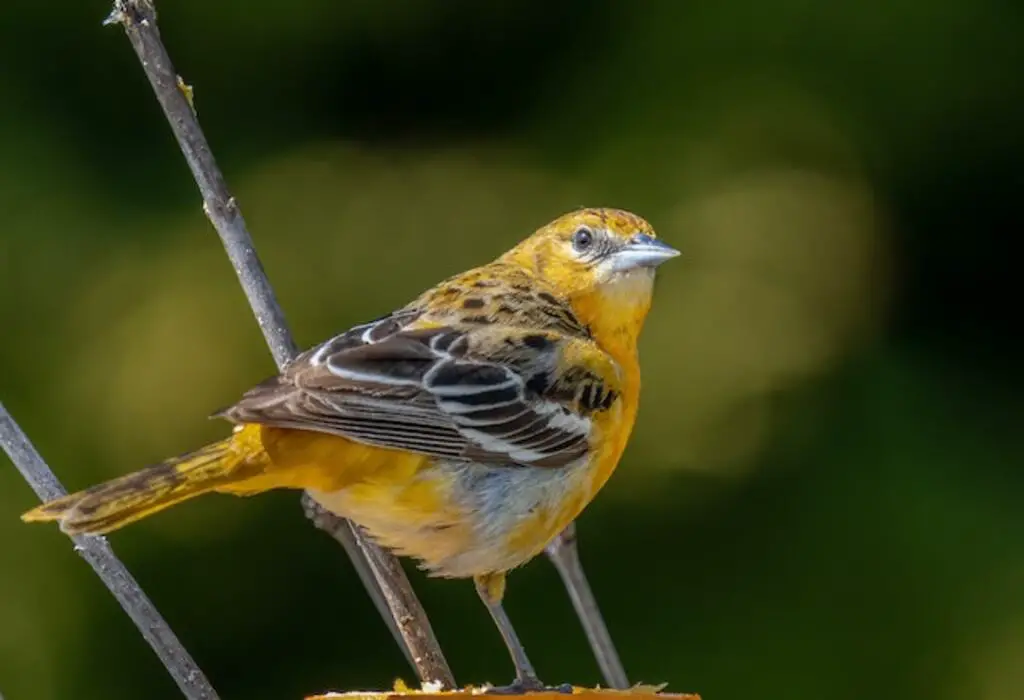Imagine a magnificent painting of a Baltimore Oriole, the colors and details of the artwork are breathtaking.
The painting captures the essence of the striking male Baltimore Oriole, with its vibrant orange and black plumage, contrasting against the lush greenery of its habitat.
However, the female Baltimore Oriole is often overlooked in such depictions, as her appearance is less striking than her male counterpart. But what does a female Baltimore Oriole look like?
In this article, we will explore the physical characteristics of female Baltimore Orioles and how they differ from their male counterparts.
We will delve into their importance for identification purposes and their behavioral characteristics.
Additionally, we will examine the habitat and distribution of these birds, as well as their conservation status and threats.
By the end of this article, readers will have a comprehensive understanding of what a female Baltimore Oriole looks like, and why they are an integral part of the species.
Table of Contents
- 1 Overview of Baltimore Oriole Species
- 2 Physical Characteristics of Male Baltimore Orioles
- 3 What Does A Female Baltimore Oriole Look Like?
- 4 Distinct Appearance of Female Baltimore Orioles
- 5 Comparison with Male Baltimore Orioles
- 6 Importance of Identifying Female Baltimore Orioles
- 7 Habitat and Distribution
- 8 Behavioral Characteristics
- 9 Conservation Status and Threats
- 10 Frequently Asked Questions
- 10.1 How do Baltimore Orioles mate and reproduce?
- 10.2 What is the lifespan of a female Baltimore Oriole?
- 10.3 Do female Baltimore Orioles migrate to different regions than males?
- 10.4 What is the diet of female Baltimore Orioles?
- 10.5 How do female Baltimore Orioles interact with other bird species in their habitat?
- 11 Conclusion
- 12 Author
Overview of Baltimore Oriole Species
The Baltimore Oriole species can be differentiated from other orioles by their vibrant orange and black plumage.
They are a migratory bird species that typically breeds in North America before migrating to Central America during the winter months.
They are known for their unique nesting habits, often weaving their nests into the branches of trees.
While the male Baltimore Oriole is known for its striking colors and distinct physical features, the female Baltimore Oriole is less vivid in color, with a predominantly yellow-brown plumage.
Moving on to the physical characteristics of male Baltimore Orioles…
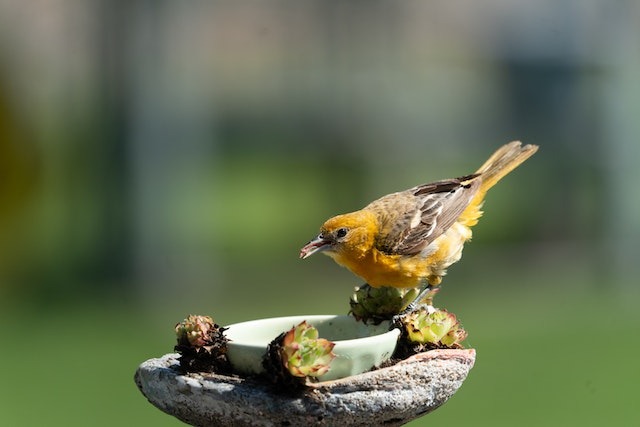
Physical Characteristics of Male Baltimore Orioles
This section details the physical characteristics of male Baltimore Orioles. Males are typically larger than females, with a length of 7-8 inches and a wingspan of 9-12 inches.
They have a distinctive bright orange plumage on their head, breast, and underparts, with black wings, back, and tail. The wings have white bars and the tail is pointed.
The bill is long, straight, and sharp, perfect for probing flowers for nectar or fruit for insects.
In contrast, females have a more muted coloration, with a yellow-green head and back, and an orange-yellow breast and underparts.
The wings and tail are also brownish-black, and the bill is shorter and more curved.
The size differences between males and females, as well as the distinct feather coloration, make it easy to distinguish between the sexes.
What Does A Female Baltimore Oriole Look Like?
The female Baltimore Oriole boasts a more subtle appearance compared to her vibrant male counterpart. She sports a combination of yellow and grayish-brown plumage, with hints of orange on her underparts.
Discover more about the distinct characteristics that make her a beautiful and unique member of the Oriole family.
Distinct Appearance of Female Baltimore Orioles
Female Baltimore Orioles possess a unique coloration that distinguishes them from their male counterparts, with a yellow-green head and back, and an orange-yellow breast and underparts, which is surprising considering that the two sexes share over 98% of their DNA.
The females also have a slightly smaller body size than males, and their wings are shorter and rounder.
These coloration variations are believed to have evolved due to the females’ nesting behavior, as their subdued colors provide better camouflage when incubating eggs and caring for their young.
While male orioles are known for their vibrant orange and black plumage, female orioles are just as important for their roles in reproduction and survival.
Understanding the distinct appearance and behavior of female Baltimore Orioles is crucial for conservation efforts, and for appreciating the diversity and complexity of the natural world.
In the following section, we will compare and contrast the physical characteristics of male and female Baltimore Orioles.
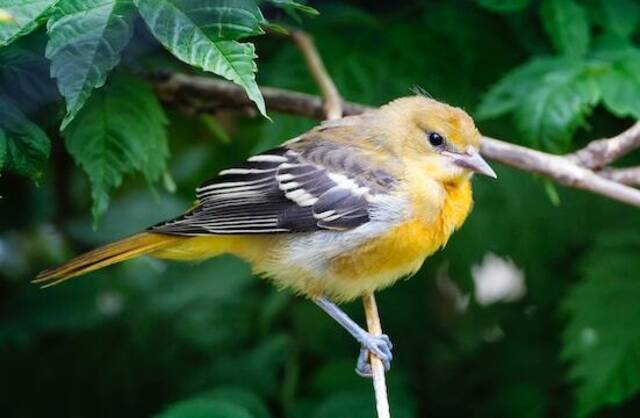
Comparison with Male Baltimore Orioles
A comparison between the physical characteristics of male and female Baltimore Orioles reveals notable differences that contribute to their distinct appearances.
While male Baltimore Orioles have bright orange plumage with black wings and back, females have a more subdued yellow-orange color with grayish-brown wings and back.
Additionally, males have a black throat and a white bar on their wings, while females have a more uniform coloration.
These differences in appearance are not just for show, as they also reflect behavioral differences and breeding patterns.
For example, males use their bright colors to attract mates and defend their territory, while females use their more camouflaged appearance to protect their nests and young.
Understanding these differences is important for identifying female Baltimore Orioles in the field, as they can often be mistaken for other species.
Importance of Identifying Female Baltimore Orioles
Identification of the female Baltimore Oriole is crucial in understanding their behavior and distribution, as studies have shown that females play a significant role in selecting breeding sites, with up to 80% of nests being built by females.
It is important to be able to distinguish between male and female Baltimore Orioles, as they exhibit different physical characteristics.
Female Baltimore Orioles have a yellowish-green coloring with a grayish head, back, and wings, while males have a bright orange plumage with black wings and a black head.
The significance of identifying female Baltimore Orioles lies in their nesting habits, as females are responsible for choosing the location and building the nest.
By understanding their behavior and habitat preferences, we can better protect and conserve this species.
This leads us to the next section about their habitat and distribution.
Habitat and Distribution
Understanding the habitat and distribution of Baltimore Orioles is crucial in ensuring their survival and promoting biodiversity in the ecosystem.
Baltimore Orioles inhabit a variety of habitats, including forests, orchards, and suburban areas with mature trees.
They are widely distributed across North America, ranging from southern Canada to central Mexico.
During the breeding season, Baltimore Orioles are found in the eastern and central regions of North America.
They follow a migratory pattern, with most populations moving south for the winter, some as far as Central America.
The timing and extent of migration vary depending on the population and location, with some birds remaining in their breeding range year-round.
By studying the migratory patterns and habitat preferences of Baltimore Orioles, we can gain a better understanding of their needs and develop conservation strategies to protect these beautiful birds.
In the next section, we will explore the behavioral characteristics of Baltimore Orioles to further our understanding of these fascinating creatures.
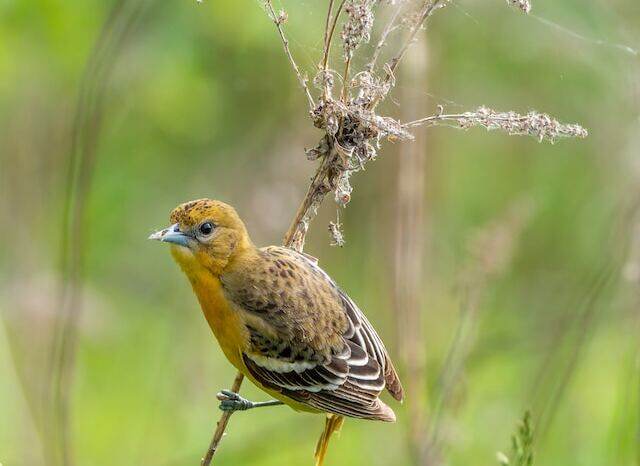
Behavioral Characteristics
The study of the behavioral characteristics of Baltimore Orioles provides valuable insights into their social interactions, communication, and reproductive strategies, allowing for a more comprehensive understanding of their ecological role and contributing to the conservation efforts of these birds.
Female Baltimore Orioles are responsible for constructing the nest, which is a hanging pouch made of plant fibers, hair, and string.
They typically lay 3-7 eggs and incubate them for about two weeks until they hatch. Once the chick hatches, both parents take turns feeding them until they fledge.
Orioles are known for their distinct vocalizations, which are used to communicate with their mate and offspring, as well as to defend their territory from intruders.
In addition to their vocalizations, orioles also use visual displays to communicate, such as wing waving and tail flicking.
These communication patterns are important for maintaining social bonds and coordinating reproductive efforts.
While Baltimore Orioles are not currently considered threatened, habitat loss and climate change could have significant impacts on their populations in the future.
Conservation Status and Threats
The conservation status and potential threats faced by Baltimore Orioles are crucial to consider in light of future habitat loss and climate change.
These birds are listed as a species of Least Concern by the IUCN, but their populations have been declining in some regions due to habitat loss and fragmentation.
Human impact, such as urbanization and agricultural practices, poses a significant threat to these birds.
Conservation efforts include the protection and restoration of their habitat, as well as the implementation of responsible land-use practices.
Additionally, research on the effects of climate change on Baltimore Orioles is ongoing, as these birds may face further challenges in the future.
It is important to continue to monitor and address these threats to ensure the survival of these beautiful birds.
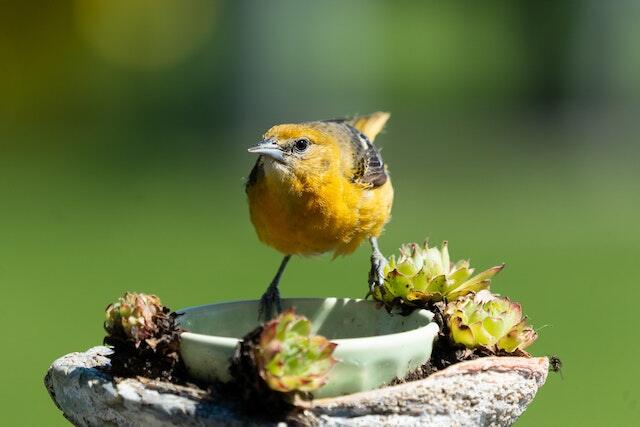
Frequently Asked Questions
How do Baltimore Orioles mate and reproduce?
Ah, the elusive mating habits of the Baltimore Oriole. It’s a topic that’s sure to get the blood pumping and the feathers ruffling.
Nesting habits and courtship behavior are essential components of the Baltimore Oriole’s reproductive strategy.
The male Oriole will build a hanging nest, which he will then decorate with various bits of string and yarn to attract a mate.
Once he has found a suitable mate, the pair will engage in a series of complex courtship behaviors, including singing and dancing, before finally mating.
The female Oriole will then lay her eggs in the nest, which the pair will take turns incubating until they hatch.
So, if you’re looking for a little avian romance, look no further than the Baltimore Oriole.
Just don’t expect them to tell you what a female looks like – they’re far too busy building nests and raising young to bother with such trivial matters.
What is the lifespan of a female Baltimore Oriole?
The lifespan of a female Baltimore oriole is typically shorter than that of the male, with an average lifespan ranging from 4 to 6 years. However, some females have been known to live up to 10 years in the wild.
Female Baltimore orioles are similar in appearance to males, with bright orange underparts and black wings and back. However, they lack the distinctive black hood and have a more subdued coloration overall.
Females play an important role in reproduction, as they build the nest and incubate the eggs. Once the chick’s hatch, both parents take turns feeding and caring for them.
Understanding the lifespan and appearance of female Baltimore orioles is crucial for conservation efforts, as these birds play an important role in maintaining ecosystem balance.
Do female Baltimore Orioles migrate to different regions than males?
Baltimore orioles are migratory birds that breed in the eastern regions of North America. During the breeding season, male orioles display their bright orange plumage and sing to attract a mate.
Females, on the other hand, are less colorful with a duller orange-yellow color, and lack the distinctive black markings of males.
When it comes to migratory patterns, both male and female Baltimore orioles migrate from their breeding grounds in the eastern parts of North America to their wintering grounds in Central America and northern South America.
However, research suggests that female orioles tend to migrate a bit earlier than males.
Breeding habits of Baltimore orioles include building intricate nests using plant fibers, grasses, and other materials.
These nests are often suspended from tree branches and are woven so tightly that they can hold water.
Overall, Baltimore orioles are fascinating birds that display unique breeding habits and migratory patterns, making them a subject of interest for ornithologists and bird enthusiasts alike.
What is the diet of female Baltimore Orioles?
The diet of female Baltimore Orioles consists mainly of insects, fruits, and nectar. They are known to feed on caterpillars, spiders, and beetles, as well as berries, oranges, and grape jelly.
These birds are also attracted to sugar water and will visit hummingbird feeders.
Female Baltimore Orioles are known for their unique nesting habits, which involve weaving a hanging pouch-like structure made of plant fibers and grasses.
They typically lay 3-7 eggs and incubate them for about two weeks. Once hatched, the chicks are fed a diet of insects and fruit by both parents.
Bird feeding and providing suitable nesting sites can help support the population of these beautiful birds.
How do female Baltimore Orioles interact with other bird species in their habitat?
Female Baltimore orioles are known for their unique social behavior and nesting habits.
They are often found in mixed-species flocks with other birds, where they forage and communicate with each other using a variety of calls.
These flocks may consist of members of different species, but female orioles are known to form strong bonds with other orioles and may even engage in allopreening, or mutual grooming.
During nesting season, female orioles are fiercely territorial and will defend their nests from other birds, including males of their own species.
They typically build their nests in trees, using a combination of plant fibers, grasses, and other materials. Overall, female Baltimore orioles are fascinating birds with complex social lives and unique nesting habits.
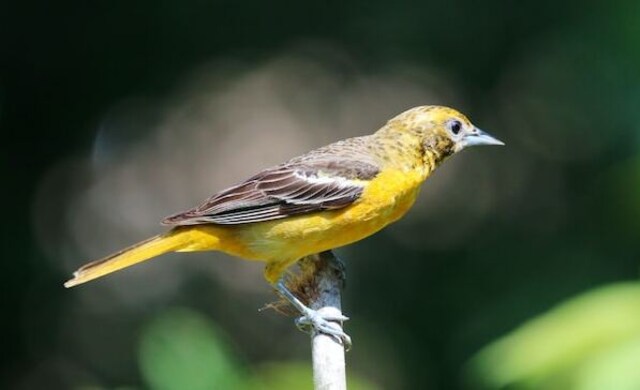
Conclusion
The Baltimore Oriole species is known for its vibrant colors and melodic songs. While the male Baltimore Oriole is easily recognizable, the female Baltimore Oriole’s appearance is often overlooked.
The female Baltimore Oriole has a distinct appearance, with a duller orange-yellow coloration and less prominent black markings.
Identifying female Baltimore Orioles is important for researchers and bird enthusiasts alike, as it helps to better understand the species’ behavior and population.
Baltimore Orioles can be found throughout North America, primarily in wooded areas with open spaces for nesting. They are known to be migratory birds, traveling south for the winter months.
The species’ conservation status is of concern due to habitat loss and fragmentation, as well as the use of pesticides that harm their food sources.
It is important for individuals to take steps to protect Baltimore Orioles and their habitats, such as planting native plants and avoiding pesticide use.
In conclusion, the Baltimore Oriole species is a fascinating and important part of North America’s wildlife.
Understanding the distinct appearance and behavior of female Baltimore Orioles is crucial for conservation efforts and research.
Let’s ensure the survival of these beautiful birds for future generations. Protect their habitats and food sources to preserve their presence and bring joy to generations to come.

